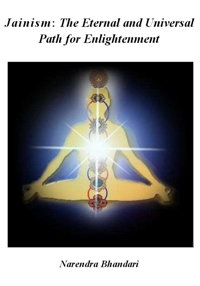Some inconsistencies in Jain geography and cosmology with modern science
Science has made tremendous progress in observational techniques and theoretical modelling during the last four hundred years, since Galileo first looked at celestial bodies with his telescope and Newton enunciated the laws of motion. As mentioned before, Jainism considers Lokvad as an essential part of its darśan and asserts that the truth is intervowen with the universe. We cannot therefore ignore the scientific studies. It may be noted here that science and Jainism, both are quests for truth and at least in the physical aspects, they both should be consistent. This has to be considered within the framework of their limitations. Science can be incomplete, always amenable to modification, but cannot be wrong as it is based on observations. Of course it carries with it the limitations of indriyas and intellect used for observations and comprehension. Jainism, on the other hand, has no such limitations since the jnān given by Tirthankaras is indriyateet. Unfortunately there is no record of direct and verbatim rendition of words spoken by the Enlightened. They all have been compiled much later and have been subjected to interpretation. They are thus subject to limitations posed by the competence of the compilers.
The glaring inconsistent aspects between Jain scriptures and modern science mainly relate to
- Geography: Remote sensing by space techniques have given us very clear picture of geography of the earth and planets
- Cosmology: Here "cosmology" is taken as to include planetary sciences too.
Under these two general headings, we list below some of the concepts mentioned in the scriptures which appear to be "erroneous":
Flat earth concept:
Jambu Dwip Pannati describes the flat earth theory, with two suns and two moons. This theory appears to be a concept prevalent at that time in the west as well as in the orient and does not seem to be an exclusive Jain concept. Some Jain scholars have tried to fit in existence of two suns and two moons in the following manner: There is a theory of formation of planets which postulates that in the beginning, before our solar system came in to existence, two stars (one of them being our sun) had a close encounter and pulled out material from each other in a cigar shaped mass, which subsequently coalesced in to planets. The other star then moved far away on its course and it is not possible to identify it now. This theory is no longer in vogue and has been replaced by the theory of solar nebula formed from a cold, rotating, dense molecular cloud which gave rise to Sun and planets as it contracted. The two moon theory is explained on the basis that the Earth at times, temporarily captures another satellite as the small bodies of the solar system (asteroids) pass by. This is quite plausible and has happened occasionally, though at present the earth has only one big satellite, our Moon and millions of small bodies (dust particles) going around. These small bodies can hardly be called natural satellites. The period of day and night varying between about 18 and 6 hours, mentioned in the Surya and Chandra Pannati do not fully give the range of their periods from polar to equatorial regions of the earth (which ranges up to 6 months), and is probably a result of limitation of observation from the limited region of Jambudwipa, that is presumed to be India.
- Distance and motion of Sun, Moon and other planets.
The distances of the Sun and Moon from the earth are mentioned about equal (800 yojans). In fact the scriptures mention that sun is slightly closer to the earth than moon (may be because the sun is brighter?). This is totally erroneous. The sun is 400 times bigger and 400 times farther from the earth as compared to the moon.
- Structure of the universe:
It is mentioned that the universe has a peculiar shape (Fig. 8.1b). Such a structure is absolutely unstable. This may be taken as projection of a three (or four?) dimensional structure on two dimensional sheet of paper. Cosmological models mentioned in the scriptures depict a multi- angular shaped Loka within infinite Aloka. Physics demands that (1) natural shapes are not angular and stable; spheroids, ellipsoids and disks are natural stable shapes (2) there should be an interface between any two bodies or two media with different properties i.e. between Loka and Aloka. One cannot sharply end where the other begins as has been seen in many celestial systems.
- Shape of Jambu Dwipa:
Remote sensing and photography from space has given us a definite idea about the shape of continents on the earth. According to scriptures, the continents are circular, each surrounded by a salty ocean (Lawan samudra), each outer structure being twice the size of the previous one. This is certainly not correct. This reminds us of quantum mechanical model of the atomic orbits where orbits go in an integral function of n (n=1,2,3...).
Likewise there are other innumerable examples which are not consistent with modern science. The list is long and would need a separate treatise to discuss all of them but we have chosen only a few examples mentioned above to illustrate that many concepts need to be critically examined and revised. Many of these problems have been pointed out by several scholars, specially B.R. Singhvi in his book "Jain Dharma ki asangat batein (1943)".
We may reemphasise that these concepts have been compiled by later scholars, much after Mahāvir, and have been influenced by other prevalent ideas and are not a direct rendition of the Tirthankar's words.
One may wonder that if so many errors have crept in over the course of time, then what is the reliability index of scriptures. In this context, we want to mention that there indeed exist many valuable concepts in the scriptures and they represent a deep understanding of the universe, notwithstanding the points made above. Without being influenced by the high precision of calculations and numbers given in the scriptures, each calculations must be critically examined in view of the large mass of the scientific knowledge now available before they are accepted as the words of the Enlightened. Some concepts may go beyond the modern scientific thought and their study may throw new light.
 Prof. Dr. Narendra Bhandari
Prof. Dr. Narendra Bhandari
